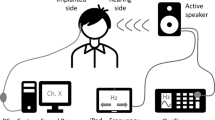Abstract
Poor pitch resolution has been shown to have negative implications for speech and music perception in implanted patients. Surprisingly, works on the subject have not focused much on the impact that the non-correspondence between frequencies allocated to electrodes and perceived frequencies could have on speech and music perception. The aim of the present study is to investigate the correlation between pitch mismatch and speech performance with the implant, and to ascertain the effects of mismatch correction through a mapping function making a personalized frequency reallocation possible. We studied ten postlingually deaf adult patients with detectable bilateral residual hearing, implanted in our Clinic with Cochlear® Nucleus devices. In each test session, we asked the patients to find the best match between the pitch elicited by the residual ipsilateral and contralateral pure tones and the pitch elicited by stimulation of electrodes. We also assessed patients’ vowel and consonant recognition performance. Finally, in the only implanted patient in our clinic who had bilateral residual hearing and used a Digisonic DX10/C® device, which makes manual electrode-by-electrode frequency reallocation possible, we modified electrode-assigned frequency ranges on the basis of the pitch matching test results. We found that in none of the studied patients, the electric-to-acoustic pitch matching corresponds to the theoretical assignment pattern. A very strong correlation was detected between the electric-to-acoustic pitch mismatch and patient’s speech performance. In the Digisonic® patient, a remarkable improvement in all phoneme recognition scores was obtained 1 month after frequency reallocation. In the light of our results, we propose to assess, whenever possible, any frequency-to-electrode mismatch in all implanted patients, and correct it through mapping programs allowing manual frequency reallocation for the pitch-matched electrodes, and automated allocation of the non-tested electrodes. Cochlear implantation should therefore be proposed when residuals for all frequencies are still present, at least in one ear, so as to allow optimal alignment between allocated and subjectively perceived frequencies.











Similar content being viewed by others
References
Gantz B, Turner C, Gfeller K, Lowder M (2005) Preservation of hearing in cochlear implant surgery: advantages of combined electrical and acoustical speech processing. Laryngoscope 115:796–802
Nelson P, Jin S-H (2004) Factors affecting speech understanding in gated interference: cochlear implant users and normal-hearing listeners. J Acoust Soc Am 115:286
Qin MK, Oxenham AJ (2006) Effects of introducing unprocessed low-frequency information on the reception of envelope-vocoder processed speech. J Acoust Soc Am 119:2417–2426
Olszewski C, Gfeller K, Froman R, Stordahl J (2005) Familiar melody recognition by children and adults using cochlear implants and normal hearing children. Cochlear Implants Int 6:123–140
Kong Y, Stickney G, Zeng F (2005) Speech and melody recognition in binaurally combined acoustic and electric hearing. J Acoust Soc Am 117:1351–1361
McDermott H (2004) Music perception with cochlear implants: a review. Trends Amplif 8:49–81
Dunn C, Tyler RS, Witt SA, Gantz BJ (2006) Effects of converting bilateral cochlear implant subjects to a strategy with increased rate and number of channels. Ann Otol Rhinol Laryngol 115:425–432
Gfeller K, Turner C, Oleson J, Zhang X, Gantz B, Froman R, Olszewski C (2007) Accuracy of cochlear implant recipients on pitch perception, melody recognition, and speech reception in noise. Ear Hear 28:412–423
Fishman K, Shannon RV, Slattery WH (1997) Speech recognition as a function of the number of electrodes used in the SPEAK cochlear implant processor. J Speech Hear Res 40:1201–1215
Firszt JB, Koch DB, Downing M, Litvak L (2007) Current steering creates additional pitch percepts in adult cochlear implant recipients. Otol Neurotol 28:629–636
Di Nardo W, Cantore I, Cianfrone F, Melillo P, Fetoni A, Paludetti G (2007) Differences between electrode-assigned frequencies and cochlear implant recipient pitch perception. Acta Otolaryngol 127:370–377
Blamey PJ, Dooley GJ, Parisi ES, Clark GM (1996) Pitch comparisons of acoustically and electrically evoked auditory sensations. Hear Res 99:139–150
Dorman MF, Spahr T, Gifford R, Loiselle L, McKarns S, Holden T, Skinner M, Finley C (2007) An electric frequency-to-place map for a cochlear implant patient with hearing in the nonimplanted. Ear JARO 8:234–240
Baumann U, Nobbe A (2006) The cochlear implant electrode-pitch function. Hear Res 213:34–42
Greenwood DD (1990) A cochlear frequency-position function for several species-29 years later. J Acoust Soc Am 87:2592–2605
Rabinowitz WM, Eddington D (1995) Effects of channel-to-electrode mappings on speech reception with the Ineraid cochlear implant. Ear Hear 16:450–458
Fu QJ, Shannon RV (1999) Effects of electrode configuration and frequency allocation on vowel recognition with the Nucleus-22 cochlear implant. Ear Hear 20:332–344
Friesen LM, Shannon RV, Slattery WH 3rd (1999) The effect of frequency allocation on phoneme recognition with the nucleus 22 cochlear implant. Am J Otol 20:729–734
Fu QJ, Shannon RV, Galvin JJ 3rd (2002) Perceptual learning following changes in the frequency-to-electrode assignment with the Nucleus-22 cochlear implant. J Acoust Soc Am 112:1664–1674
Reiss LAJ, Turner CW, Erenberg SR, Gantz BJ (2007) Changes in pitch with a cochlear implant over time. JARO 8:241–257
Author information
Authors and Affiliations
Corresponding author
Additional information
An erratum to this article can be found at http://dx.doi.org/10.1007/s00405-008-0674-0
Rights and permissions
About this article
Cite this article
Nardo, W.D., Cantore, I., Marchese, M.R. et al. Electric to acoustic pitch matching: a possible way to improve individual cochlear implant fitting. Eur Arch Otorhinolaryngol 265, 1321–1328 (2008). https://doi.org/10.1007/s00405-008-0655-3
Received:
Accepted:
Published:
Issue Date:
DOI: https://doi.org/10.1007/s00405-008-0655-3




